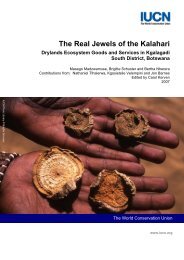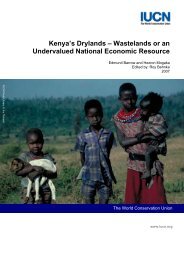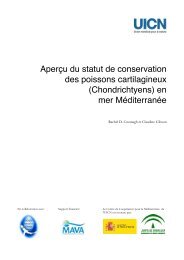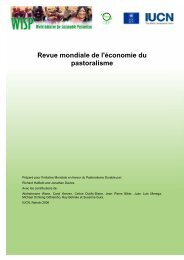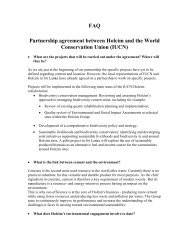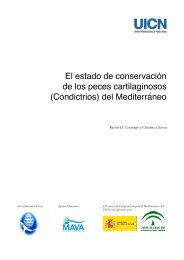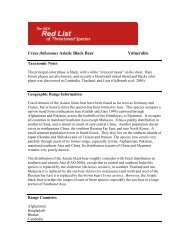iucn mediterranean sharks (pdf) - The Shark Trust
iucn mediterranean sharks (pdf) - The Shark Trust
iucn mediterranean sharks (pdf) - The Shark Trust
You also want an ePaper? Increase the reach of your titles
YUMPU automatically turns print PDFs into web optimized ePapers that Google loves.
Conservation of Atlantic Tuna (ICCAT) introduced legislationto ban the use of pelagic driftnets within the Mediterraneanbasin. If implemented, this would eliminate one of the mostsevere threats to the giant devil ray. Without implementationof these measures, it is inferred that this giant ray will becomeincreasingly rare in the Mediterranean; it is assessed asEndangered. Strict enforcement of protection and raisingawareness with fishermen may prevent this ray frombecoming more threatened in the future (Notarbartolo diSciara et al. 2006).4.3 White shark Carcharodon carcharias(Linnaeus, 1758)Mediterranean: Endangered A2bc+3bc+4bcGlobal: Vulnerable (2000). Update in preparationMediterranean assessment authors: Fergusson, I.K.,Soldo, A., Morey, G. and Bonfil, R.This flagship species has long been the focus of negativemedia attention as a result of its occasional lethal interactionswith humans and perceived nuisance to some commercialfisheries (Fergusson et al. 2005). Due to this muchexaggerated perception there are occasional attempts tocapture and kill these <strong>sharks</strong>, which have been targeted inthe past for sportfishing, commercial trophy hunting orhuman consumption (although no directed Mediterraneanfishery has ever existed) (Fergusson et al. 2005). Althoughcurrently under review, the white shark has been listed asglobally Vulnerable on the IUCN Red List since 2000.However, it is considered to be at a higher risk of threat in theMediterranean, and has therefore been assessed asEndangered in this region (Fergusson et al. in prep.).Historical quantitative data for Carcharodon carcharias inthe Mediterranean are patchy, but available informationprovides sufficient evidence for declines of 50–60% to beinferred and an increasing scarcity of white <strong>sharks</strong> throughthe latter half of the 20th century (Fergusson et al. in prep.).Records are declining despite increased scientific monitoring(especially in Italy, Malta, Croatia, Tunisia and Spain) andconsiderable growth in tourism and resort developmentduring the last 40 years, which should have increasedopportunities for sightings.Offshore records in the Mediterranean have includedcaptures across all size-classes made by pelagic longlines,bottom trawls, driftnets and purse seines. C. carcharias hasa tendency to approach boats readily and to scavenge fromfishing gear, which increases their vulnerability, potentiallyresulting in accidental entrapment or deliberate killing bycommercial fishermen (Fergusson et al. 2005). In certainregions, such as Sicily, the white shark has traditionally beenviewed negatively, as a costly interference to fisheries(Fergusson et al. in prep.). <strong>The</strong> impact of habitat degradationmight be especially acute in the Mediterranean, wheregrowing areas of intensive human inhabitation, especiallyfor tourism, overlap with white shark habitat . Declines oftraditional regionally- important prey such as blue fin tuna(Morey et al. 2003; Soldo and Dulcic 2005) alongside threatsto other important prey, including small cetaceans (Moreyet al. 2003) and other demersal and pelagic fishes, aresuspected to have had a serious impact on white <strong>sharks</strong> inthe Mediterranean (Fergusson pers. comm.).Entrapment in fixed tuna rearing pens and towed tunacages may also pose a threat to white <strong>sharks</strong> in the region.Although little is known of the direct impacts of tunacages, their increasing use, evidence for unreportedencounters (Morey pers. comm.), and the potential forwhite <strong>sharks</strong> to be illegally killed through conflict withindustry workers raises concerns. Similar issues are knownto have arisen in southern Australia and Mexico (Galazand Maddalena 2004).<strong>The</strong> Mediterranean white shark population is classifiedas Endangered on the evidence of declines and the likelyfishery pressures placed upon their apparent reproductiveand nursery grounds in the Sicilian Channel (Fergussonet al. in prep.). This species has been included in bothAppendices of the Convention of Migratory Species (BonnConvention) since 2002, with the objective of providinga framework for an improved coordination by range statesto adopt and enact protective measures (see 5.1.1). It hasalso been listed on Appendix II of the Convention onInternational Trade in Endangered Species (CITES) since2004 (see 5.1.2). In the Mediterranean, the white shark islisted as an ‘Endangered species’ on Annex II of theBarcelona Convention (see 5.2.2), and as a ‘Strictlyprotected species’ on Appendix II of the Bern Convention(see 5.2.1). Since October 1999 the white shark has beenprotected in Maltese waters by specific legislation enactedunder its Environment Protection Act No. 5 (1991) Floraand Fauna Protection (Amendment) Regulations 1999, andwas also recently declared a strictly protected species inCroatian waters.Conservation management of this species in theMediterranean Sea poses a challenge as it is rare, wideranging and diffusely distributed, with little known onseasonal movements or key elements of its population biology(Fergusson 1996; 2002). Effective enforcement ofmanagement measures already in place could significantly14



